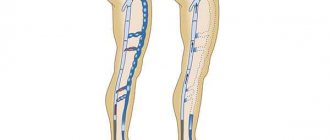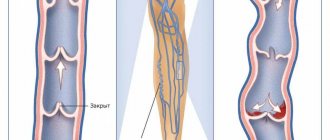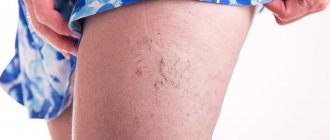Compression garments for varicose veins normalize blood flow, partially compensate for valve insufficiency, and relieve pain and fatigue. It is used both before treatment of varicose veins and after to facilitate recovery. They are effective in conservative and minimally invasive treatment, eliminate the need for dressings, and allow you to obtain an actual result that corresponds to the predicted one (1, English).
In 2021, a large study was conducted on the effect of compression hosiery in the conservative treatment of varicose veins. It turned out that when using the first class of compression, the course of the disease slows down significantly, pain and swelling disappear. (2, English). The positive effect of compression after surgical and minimally invasive treatment has been proven many times; large studies have been conducted since 1985 (3, English).
Currently, three types of compression underwear are produced - tights, stockings of various heights and knee socks. The compression class is prescribed by a phlebologist during a face-to-face consultation.
Watch the video!
Phlebologists talk about the benefits of compression hosiery in the treatment and prevention of varicose veins. Find out what it is like and how to make a choice.
Elastic compression of the lower extremities is by no means new in medicine. Back in Ancient Egypt, slaves and workers practiced foot binding to increase endurance and performance, and legionnaires of the Roman Empire bound their feet during long walks. A similar method was used later, in the 17th-19th centuries, by factory and plantation workers to speed up the recovery process and reduce swelling of the limbs after a hard day.
Compression bandages may be beautiful, but they do not solve the immediate problem well enough.
The method of dosed external compression was also used in medicine. The feasibility of its use in venous pathology was identified back in the time of Hippocrates. Even then, a disease was described with the presence of bulging superficial vessels on the leg, swelling of the affected limb and a tendency to form ulcers. And for its treatment, bandages and pressure spiral bandages were widely used.
This technique was not forgotten. Gradually, new methods of bandaging limbs for varicose veins and chronic venous insufficiency were developed. Elastic compression was also used as an independent method. The materials most often used were cotton and knitted fabric and rubber strips.
The breakthrough was the appearance of an elastic bandage. It was patented in 1845 by British entrepreneur and inventor Stephen Perry and was subsequently improved. Subsequently, bandages of 3 degrees of elongation based on various materials began to be produced. They are still in use today. But elastic bandaging has a number of significant disadvantages.
Disadvantages of an elastic bandage:
- inconvenience;
- dependence of the result on careful adherence to the application technique;
- the likelihood of uneven distribution of compression;
- unaesthetic;
- risk of displacement of material turns.
In 1848, another product was patented, which gave impetus to the emergence of a new direction in compression therapy. William Brown invented stockings that allowed distributed circular pressure to be applied to the lower limbs. Over time, advances in light industry made it possible to produce tights. And currently, it is compression hosiery that is recommended for use in various diseases affecting the veins of the lower extremities.
Classification of compression hosiery
Modern compression products are available in the form of tights, stockings of various heights and knee socks. But they are divided not only by appearance. They are also divided into classes according to the degree of compression they provide. It is measured in millimeters of mercury.
An example of a compression stocking from a famous Asian manufacturer
The classification of compression products used in our country is based on the German standard RAL-GZ 387 adopted in Europe. It is the most strict and regulates the nature of pressure distribution and its compliance with the physiological patterns of venous outflow, the quality and composition of the materials used.
Compression garments are divided into 4 classes:
- Easy. Compression 18–21 mm Hg.
- Average (moderate). Compression 23–32 mm Hg.
- Strong. Compression 34–46 mm Hg.
- Very strong. Compression 49 mm Hg.
The term “tightness” is sometimes used to describe compression tights and stockings. In fact, it is an incorrect replacement for the concept of “compression”. This pseudo-medical formulation is based on the fact that with an increase in the level of pressure applied, the underwear actually becomes less stretchable and denser to the touch. But using this term, and even more so trying to look for a correspondence between the compression class and the density of ordinary tights (measured in DEN) is illiterate and fundamentally wrong.
The best brands
The products of the medi company (Germany) are considered to be of the highest quality, because the company is one of the world leaders in the development of compression hosiery. Compression jersey from medi is not only comfortable and elegant, but also stylish. High-quality medi knitwear is presented in a large assortment - stockings, tights and knee socks of various shades and colors, also differing in transparency and matteness, and in design. Everyone will find the right underwear that matches not only the problem, but also your style.
Compression jersey from the Ergoforma brand is produced from special high-quality raw materials using Italian equipment. This knitwear also has a special weaving technology, which increases its wear resistance. Ergoforma compression underwear has a modern look, is super elastic and comes in a wide range of models that differ in color, shape, density, etc.
Lingerie from the Latvian company Tonus Elast is also presented in a wide range - from golf to tights for pregnant women. The products have all the necessary certificates, are of high quality and affordable. Anti-varicose tights are perfect for preventive use; you can also choose therapeutic knitwear with the desired level of compression.
What is the difference between compression underwear and regular tightening tights?
Compression hosiery does more than just compress the soft tissue of the legs. The pressure it exerts is carefully calculated and strictly dosed, which is ensured by the use of special materials with a special weave of threads and composition. According to the RAL-GZ 387 standard, tights and stockings cannot be transparent, translucent, colored or patterned.
An important characteristic of compression hosiery is the pressure gradient - its gradual decrease as it rises from the level of the ankle joint to the thigh. Moreover, these changes correspond to the physiological characteristics of the peripheral veins and the nature of blood flow.
The greatest pressure is in the supramalleolar region. Compression begins in the upper third of the foot, involving the ankle joint - it is here that the great saphenous vein originates on the medial side and its main tributaries are located. Approximately at the level of the transition of the belly of the calf muscle to the Achilles tendon, the pressure exerted by stockings (tights) is already about 65–70% of the supramalleolar pressure. At the knee it is about 50%. And in the lower third of the thigh - 40% of the original.
The gradient acts in a dosed manner on the peripheral superficial veins of the lower limb and creates a blood flow close to physiological.
Compression classes of anti-varicose products
Compression of anti-varicose underwear is the degree of force with which the product compresses the lower limbs to bring relief, eliminate swelling and restore tone to the vessels and veins.
How to choose the right compression garments
With the same weight, build and height, the proportions and volumes of all people are different. And how effectively the underwear will work on your legs is directly dependent on how thick your legs are and how much the compression products will stretch on your legs. Each manufacturer produces its own size chart, but despite this, there are generally accepted patterns and standards. In order to choose the most correct size, which is guaranteed to provide a therapeutic effect, it is important to take the correct measurements:
- Find the round protruding bone on the ankle - the “junction” of the foot and lower leg. Measure the thinnest part of the shin. It is in this area that 100% compression is created.
- Mid-calf. Central point of the calf muscle. Mentally calculate the middle of the shin (along the “calf”) and take a measurement. At this point the compression should be at 70%. When purchasing a golf course, this mark is moved under the knee.
- The next measurement point will be the mid-thigh circumference. The pressure at this point should be 40%.
Leg length for choosing the size of stockings and tights
- Measured from heel to groin. When purchasing golf shoes, you should measure the length of your leg from heel to knee.
- When purchasing tights, it is important to measure your waist and hips.
After all the measurements, compare the results with the table and choose the right size.
Anti-varicose underwear belongs to the class of goods that cannot be exchanged or returned, so choose these products as responsibly as possible so that money is not thrown away. Consult with specialists.
What changes when wearing compression garments for varicose veins?
Compression tights exert dosed circular pressure, the level of which is determined by the compression class. The most affected are the bulging varicose veins, which occurs in accordance with Laplace's law. All other superficial vessels are also pressed.
At the mechanical level:
- Reducing the diameter of venous vessels allows you to reduce the volume of deposited and stagnant blood.
- Pressing varicose veins helps reduce the effect of valvular insufficiency and reduce the return flow of blood.
- Reducing the volume of horizontal reflux through perforating vessels, increasing blood discharge into the deep veins of the leg.
- Improving the functioning of the calf muscle pump.
In general, compression tights and stockings have a symptomatic effect and reduce the severity of chronic venous insufficiency. Lingerie creates comfort for severe varicose veins. However, we cannot talk about a cure: the patient only improves the quality of life and reduces the likelihood of complications.
Compression garments do not eliminate varicose veins, do not restore the structure of the walls of peripheral vessels and cannot replace surgery. It only allows you to correct the existing signs of venous insufficiency, and this effect lasts only while wearing tights/stockings.
The result of wearing compression knitted underwear
The result of wearing compression knitted underwear:
- reduction of swelling of the lower leg and ankle joint, including in the evening and after a period of prolonged standing;
- reduction in the severity of pain, which is explained by a decrease in the degree of venous blood stagnation and improved tissue trophism;
- reducing the risk of thrombosis;
- reducing the severity of trophic disorders and reducing the likelihood of their occurrence;
- reducing the duration of the rehabilitation period after surgical interventions and minimally invasive manipulations on the veins;
- reducing the feeling of discomfort in the legs;
- reducing the frequency and severity of cramps in the leg muscles.
Wearing compression garments is advisable for varicose veins of any stage, postphlebothrombotic syndrome (PFTS). In some cases, it is also recommended for reticular varicose veins and telangiectasia (spider veins), lymphostasis of the lower extremities.
Particular importance is attached to compression therapy after operations and minimally invasive endovascular procedures (EVLO, laser obliteration, RFO). Wearing specialized knitwear significantly increases the effectiveness of such interventions.
Open or closed toe
Compression stockings are made with two types of toe. However, the products may not differ in class. An open toe is more comfortable when wearing sandals, when you sweat a lot, in hot weather, and when you need to frequently care for your toes. Knitwear with such a toe is recommended for patients with type II diabetes who are forced to control the skin in this part of the feet.
Stockings with open toes are preferable for heart problems, wearing products during and after surgical interventions. The free toe allows doctors to monitor the patient's condition based on the color of the nails.
Knitwear with an open toe is more comfortable to wear. But not everyone likes wearable models. The advantages of closed-toe stockings are that there is no risk of the knitwear slipping off the foot and gathering into folds, and it reduces heat loss in cold weather.
Indications and Contraindications
Indications
- After sclerotherapy for better contact and subsequent fibrous “gluing” of the walls of the sclerosed vessel. .
- Pronounced tissue changes due to chronic venous insufficiency (in the presence of trophic ulcers, lipodermatosclerosis).
- Phlebitis of the superficial veins.
- Swelling, pain, fatigue in the legs.
- Tendency to be overweight.
Contraindications
- clinically significant obliterating atherosclerosis of the lower extremities;
- endarteritis;
- pustular skin diseases of the lower extremities and microbial eczema;
- bedsores;
- open wounds;
- diabetes mellitus with signs of endocrine polyneuropathy and impaired microcirculation in the distal extremities;
- acute cardiovascular failure.
The ability to wear compression stockings is determined by your doctor. A change in the patient’s condition and the appearance of new symptoms requires a second consultation with a phlebologist to determine further treatment tactics.
What are varicose veins and why are they dangerous?
Varicose veins or varicose veins
- a pathological condition in which damage to blood vessels occurs. In addition to discomfort, this can cause much more serious problems. Against the background of varicose veins, the risk of inflammation of the veins, the appearance of trophic ulcers and, as a consequence, blood clots is too high. You probably know about the danger of a blood clot in blood vessels: it can clog an artery, which in most cases leads to death. But let’s not make the clouds too thick, but let’s say that these processes are curable. It is important to help yourself in time. The very first is compression garments, the indications for which are quite broad:
- venous insufficiency;
- sedentary lifestyle;
- sitting and standing work;
- pregnancy period;
- frequent and long trips, hikes;
- frequent air travel;
- swelling and pain in the legs;
- vein thrombosis;
- anomalies in the structure of the venous system.
How to choose a compression product?
Compression garments cannot be chosen independently; they are prescribed exclusively by a phlebologist based on an examination and an ultrasound scan of the veins of the lower extremities.
Making the right choice
When choosing compression, the following are taken into account:
- the nature and speed of venous blood flow;
- severity of pathological vertical and horizontal reflux;
- the presence of an obstruction to the outflow of blood, which is most often caused by thrombosis.
Many patients have a completely logical question: why go to the doctor if the package of underwear contains a description of compression classes and indications for them? Isn’t it possible to get by with the help of a consultant in an orthopedic salon?
No, self-analysis of symptoms is not enough for the correct selection of compression garments: the doctor is guided not only by the degree of venous insufficiency and clinical symptoms. Other factors are also important. And the determining parameters often become age and the presence of concomitant somatic pathology: sometimes the use of a high class of compression is fraught with a deterioration in the general condition, despite the correction of venous insufficiency.
Observe compression level and wearing mode
Risks of wearing compression class 3 in old age:
- Risk of stroke, heart attack.
- Severe cardiovascular insufficiency
Determining treatment tactics and selecting the class and type of compression hosiery is the prerogative of the doctor. But the consultant of an orthopedic salon can handle the selection of the size and height of the product. He will also give detailed care instructions and teach you how to put on compression tights and stockings correctly.
Preference should be given to brands whose manufacturers are guided by the RAL-GZ 387 standard. This will be indicated by the corresponding icon on the packaging. The standard is a guarantee of high quality, physiology and predictability.
High-quality therapeutic anti-varicose jersey is not sold in pharmacies. The products are presented in orthopedic salons.
Don’t save money – don’t buy counterfeits and products from unknown manufacturers. The compression will almost certainly differ from the declared one, and the durability of the product will be low.
Non-standard sizes and choice of therapeutic linen
What is important to know if your measurements do not fall within the standards of compression garment manufacturers:
- when choosing a product, you should give preference to knee socks in the case of non-standard ones, because the main thing is to create compression in the lower leg, where the manifestations of varicose veins begin and develop most clearly and actively.
- or give preference to products with an open nose so that the medicinal product fits correctly.
- give preference to smaller sizes so as not to lose the compression effect
- It is important to take all measurements in the morning, immediately after waking up. At this time there is no swelling and there is a guarantee that you will choose the correct size of compression garments.
How to wear and how much to wear
The stocking is first turned out and folded into a roll, and then rolled out along the leg from bottom to top. This will ensure proper pressure distribution and prevent deformation of the product. There are also special devices that make putting it on easier. They can also be purchased at orthopedic stores.
It is advisable to wear compression hosiery in the morning while still in bed: it is at this time that the swelling of the legs is usually minimal, so that optimal compression of the veins can be achieved. It is also recommended that before putting on tights, hold your legs elevated for a few minutes and “work” your feet to further increase the outflow of venous blood and lymph.
Compression anti-varicose products are sometimes worn for a long time, removed only in the evening before going to bed. Such recommendations can be given, for example, for postphlebothrombotic syndrome (PFTS), thrombophlebitis, and persistent edematous syndrome. In other cases (with initial varicose veins), it is enough to wear such stockings (tights) only for periods of static or dynamic loads. The rules for wearing compression garments are determined by your doctor.
Author of the article: Letunovsky Evgeniy Anatolyevich Last update: 09/24/2020.
Features of the effect of compression tights on varicose veins
The therapeutic effect of the underwear is achieved thanks to the correct distribution of pressure on the areas of the legs. Since more effort is placed on the area under the ankle, it is this part of the tights that has the maximum degree of compression. Towards the top of the product, the compression gradually decreases, which stimulates the active movement of blood without stagnation.
IMPORTANT! Selecting the correct pressure will remove excess stress from the legs, promoting the natural expulsion of venous fluid from the vessels.
Tights for veins: how to wear
Having purchased compression tights or stockings for varicose veins that suit you, study the recommendations for their proper use.
Before putting on tights or stockings, remove the rings - this way you will avoid damage to the products. Also remember that it is not recommended to apply creams and lotions on your legs, as this will make it difficult to put on the jersey. Put the stocking or pantyhose on your leg, holding it with both hands and trying to evenly distribute the fabric so that it fits without wrinkles. The product is put on correctly if it does not pinch the area under the knee and if the heel of the stocking is exactly in its place.
What happens with varicose veins?
“Varicose” means “bloating” in Latin.
Indeed, varicose veins, for a number of reasons, stretch, swell, and lose tone. This means that blood flows through them slowly and stagnates, further stretching the vein wall. Unfortunately, it is impossible to restore the diameter of the vein lumen. However, wearing tight compression stockings that apply pressure to the veins can help stop the progression of varicose veins. If you are recommended to wear orthopedic tights for varicose veins after surgery, then this additional pressure increases the effectiveness of the treatment.









